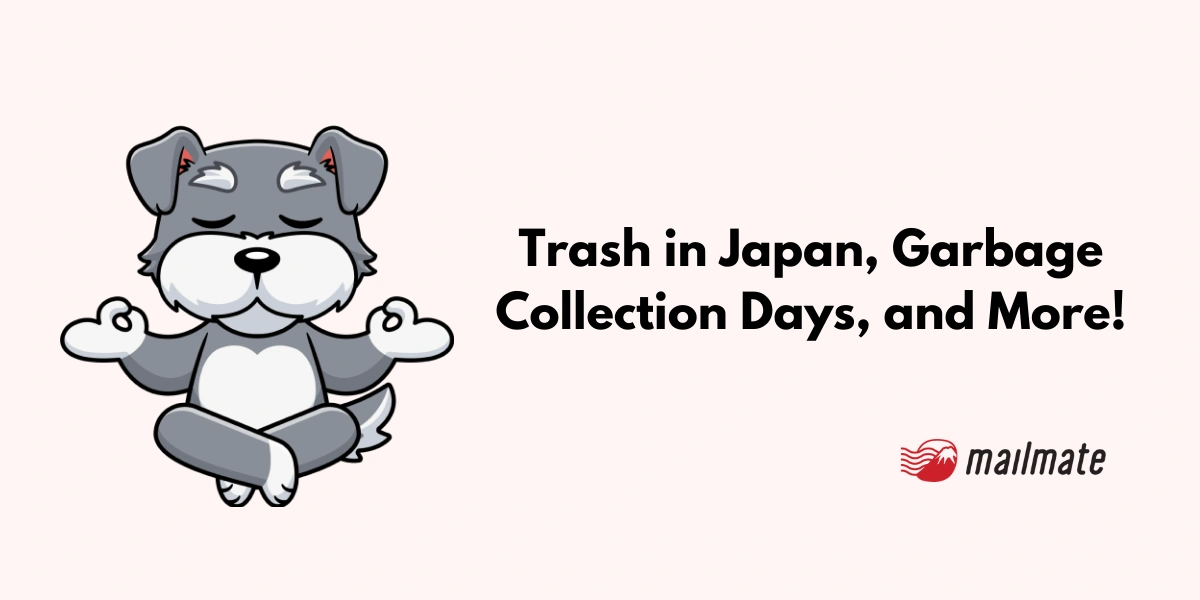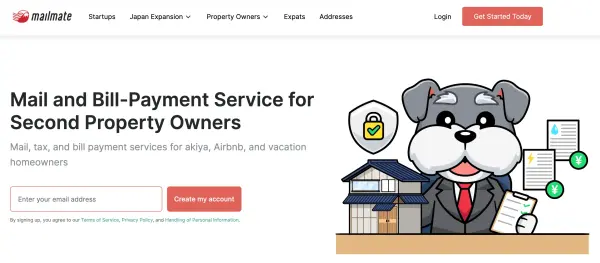Trash in Japan, Garbage Collection Days, and More!

If you've just moved to Japan or recently relocated to a new city, a common issue you may face is how to deal with your trash.
This article will answer your questions on garbage disposal in Japan, including how to put out trash, common garbage disposal rules, how to figure out trash collection days, and much more.
Let's go!
How to put out trash in Japan
Japan's residential waste management system is governed by local municipalities. This means that most of the rules regarding trash collection, including garbage collection days, will depend on the city you are in.
Here's a step-by-step to help you get up and running.
Step 1. Get the trash collection schedule for your area.
Trash collection schedules will be posted on the website of the city you have moved to.
Use the following search query to locate the trash collection schedule for your area.
Your city (in English or Japanese is OK) + ゴミ収集日 2024 (garbage collection days 2024)
For example: Minato City ゴミ収集日 2024
Input your search query into Google and use Google Chrome's translate feature to see the results in English.
You should come across a result that looks like this:

Open the link, turn on Google Translate, and navigate to the garbage disposal calendar for your area.
For example, Minato City contains many smaller municipalities.
By looking at your residential address, you can find out which municipality your house is located in and then find the garbage collection days for that municipality.
For instance, if your address is 1-10 Akasaka, Minato City, you would look for the garbage collection days for Akasaka 1. See the image below.

Step 2. Learn how to read the garbage collection calendar.
Once you have the garbage collection calendar for your area, you will need to learn to read it.
Certain areas will provide some English guidance. See Minato City's calendar below.

Other cities provide pictographic clues.

Quite often, however, this information will be in Japanese only.
By learning the following Japanese words, you'll be able to figure out what days various types of garbage are collected.
燃えるゴミ (もえるごみ) / 可燃ゴミ (かねんごみ): Burnable garbage
燃えないゴミ (もえないごみ) / 不燃ゴミ (ふねんごみ): Non-burnable garbage
資源ゴミ (しげんごみ): Recyclable waste
プラスチック: Plastic waste
ビン・缶 (びん・かん): Glass bottles and cans
古紙 (こし): Old paper
粗大ゴミ (そだいごみ): Large-sized waste
Also, pay attention to when you can put your garbage out. While exact collection times will vary from place to place, the most common times are between 7 and 8 a.m. on collection day.
Additionally, depending on your area, you may be required to put your name on the trash bag in permanent marker.
Do a Google search for garbage collection rules for your area, and use Google Translate to find out the specifics regarding collection times and any other rules relevant to your locality.
Step 3. Obtain the designated garbage bags for your area.
Every municipality has designated garbage bags that you must use to dispose of your garbage. For example, if you live in Minato City, you cannot use Shibuya City's garbage bags.
Go to the nearest grocery or drug store to your house. They will sell garbage bags designated for your city.
If you need help locating the garbage bags in the store, here are some phrases you can use:
「指定ゴミ袋はどこで買えますか?」
(Shitei gomi bukuro wa doko de kaemasu ka?)
Translation: "Where can I buy designated garbage bags?"
「このお店で指定ゴミ袋を売っていっますか?」
(Kono omise de shitei gomi bukuro o utteimasu ka?)
Translation: "Do you sell designated garbage bags in this store?"
Step 4. Find your designated collection spot.
Here are some common methods for finding the garbage collection spot for your house:
a. Ask your real estate agency.
Quite often the location of your garbage collection spot will be included in the general information regarding your area that your agency may collect on your behalf.
b. Go to your nearest local ward office and ask.
If your city has a translation service or a foriegner hotline, this is a good option for you.
To ask the local ward office regarding designated locations for garbage in Japanese, you can use the following polite phrases:
「ゴミの収集場所について教えていただけますか?」
(Gomi no shūshū basho ni tsuite oshiete itadakemasu ka?)
Translation: "Could you tell me about the garbage collection spot?"
「私の住所のゴミ収集場所を教えていただけますか?」
(Watashi no jūsho no gomi shūshū basho o oshiete itadakemasu ka?)
Translation: "Could you tell me the garbage collection spot for my address?"
Make sure to bring your home address when using this method.
c. Take a walk around your neighborhood.
Look for a shed or a large metal container. Garbage collection stations differ from city to city, but generally speaking the public garbage areas might look something like the below:

Image: Nissho

Image: Daiken
Understanding Collection Categories
Next, let's examine the different categories and proper disposal rules so that you can separate your household garbage.
Keep in mind that the following is general guidance. Each city will have its own rules regarding what qualifies as "burnable" vs. "non-burnable" garbage.
a. Burnable waste (燃えるゴミ)
Burnable garbage includes kitchen scraps, food waste, paper products, household waste that fits into the designated trash collection bag (clothes, shoes, rubber items, leather items, yard waste, grass cuttings, small branches, etc.
Some localities will also allow plastic items (plastic containers, plastic bottles, etc.) to be disposed of inside of this burnable waste category.
Collection frequency: 2-3 times per week
b. Non-burnable waste (燃えないゴミ)
Non-burnable garbage (non-recyclable waste) includes metal and glass items, kitchen utensils, kitchen pots and pans, small appliances, ceramics, broken glass, spray cans, dangerous objects (which must be wrapped to avoid harming sanitation workers), and other such items.
These unburnable garbage items must fit into the designated bags. For example, if you wish to dispose of a heater, it should fit into the designated garbage bag. If it doesn't, you'll need to look into other collection methods.
Collection frequency: typically collected 1 x a week or every other week
c. Recyclables
Even if your locality allows pet bottles to be disposed of in either burnable or unburnable garbage, most areas also have a day when they collect recyclable items.
These recyclable categories include the following:
PET bottles
Glass bottles
Aluminum and steel cans
Cardboard
Make sure pet bottles, glass bottles, and cans are clean before putting them in the garbage bins.
For cardboard, many municipalities will specify the type of string you should use to tie up your cardboard. This is often, but not always, a paper string (not hemp string) that can be bought at a 100 yen store, hardware store, or drug store.
Refer to the trash collection calendar for your area for specific details.
d. Large items (粗大ゴミ)
If you wish to dispose of oversized garbage, you must call the city office to have it taken away. Some cities will handle the disposal of large furniture up to a certain size, but this will depend on the city.
To find out the rules for disposing of large items for your city, use the following search terms:
Your city + 粗大ゴミの出し方
Please note: Because of Japan's Home Appliance Recycling Law, local city offices will not handle the disposal of washing machines, fridges, tvs, and air conditioners.
Recommended options for the aforementioned electronics include taking the item back to where it was sold to you, or, if the item is in good condition, calling a recycling center to have it picked up and resold.
Common mistakes and how to avoid them
Here’s a list of common mistakes that people make when it comes to their trash. A quick list of what not to do:
1. Mixing recyclable garbage
A common mistake that's easy to make is mixing recyclable garbage.
For example, don’t put steel cans in the aluminum can garbage bin.
In some cities, glass should also be separated into clear glass and colored glass.
2. Using the wrong bag
Don’t use a garbage bag that is not the designated bag for your city.
3. Putting your trash out at the wrong time
For example, putting your bag out too late on collection day. Or putting out burnable garbage on an unburnable garbage collection day.
4. Not cleaning items properly
I've had glass bottles not collected because they contained a tiny bit of remnant sauce. Recyclable garbage should be rinsed off before it is put out to be collected.
5. Not writing your name on the bag
If this rule applies to your area, skipping this step may result in your garbage not being collected.
In closing
I've often heard it said that neighbors will judge you by how you dispose of your garbage, as it's a way for them to evaluate how well you're able to follow and remember rules.
For new residents just starting out on their Japan journey, garbage in Japan can feel daunting. However, reading this article will get you off to a good start. Remember to follow up to find out the rules for your specific locality. (Do a Google search for your city + ゴミ収集案内).
If you're a second-home owner and aren't living in Japan full-time, consider using MailMate for your property management needs.
MailMate can help you pay taxes on your property and serve as your domestic point of contact and energy liaison, helping you connect your property to water, gas, electricity, and more.

The service includes the following features:
Tax representative for annual real estate tax payments
Domestic point of contact for authorities (required by law)
Bill pay support for property tax payments
Tax notifications with English summaries
A virtual mailbox to receive the mail that arrives at your Japanese property
Manage important property documents and notifications in one place
Other services MailMate offers include utility and Internet setup of your Japanese property!
Founded in 2019, MailMate has simplified property ownership for foreigners living abroad and is an increasingly popular option recommended by users and well-known industry figures.

Additionally, if you use MailMate's tax representative service for property owners, MailMate will take care of filing the tax representative form with the relevant tax office on your behalf.
Navigate Japan's tax system with an experienced tax representative service tailored for foreign property owners!
Spending too long figuring out your Japanese mail?
Virtual mail + translation services start at 3800 per month. 30-day money-back guarantee.

